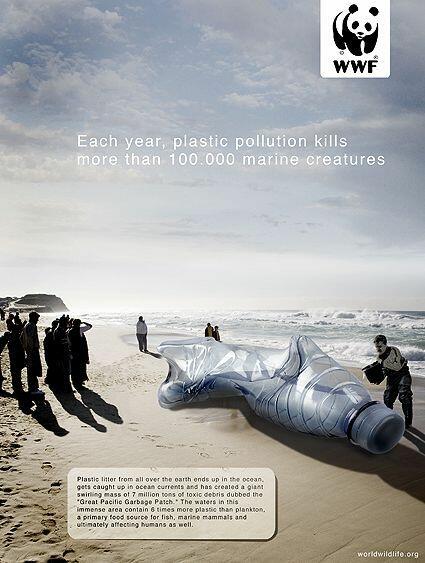Rhetoric and the art of persuasion are generally associated with spoken language and oratory. However, a visual image can also make a convincing point, and this is particularly applicable to social and environmental advertising. Its efficiency largely depends on the performance of all possible persuasive means, which Aristotle previously divided into logos, pathos, and ethos (Vu 31). Researchers note that visual rhetoric uses special techniques to build arguments such as color, lighting, and expression, and the image language can rapidly convey a persuasive advertising point (Vu 31).
Organizations such as Greenpeace and the World Wide Fund for Nature (WWF) often use visual rhetoric to draw public attention to specific environmental issues. This paper analyzes the WWF’s environmental advertisement on marine and ocean pollution (WWF). Its visual argument is that plastic contamination is extremely dangerous for marine creatures, and it uses all three types of information to make a convincing point – logos, pathos, and ethos.
Logos
This category of information includes argumentative reasoning that is designed predominantly through logical, verbal means. According to Vu, “logos shows the organization of the arguments that lead the listener to conclusions that benefit the discourse” (31). In this case, the logos contains the text depicted in the advertisement. Below is the title of the advertisement and the body text, which contains the chain of reasoning and statistical data.
- Each year, plastic pollution kills more than 100.000 marine creatures.
- Plastic litter from all over the earth ends up in the ocean, gets caught up in ocean currents and has created a giant swirling mass of 7 million tons of toxic debris dubbed the “Great Pacific Garbage Patch.” The waters in this immense area contains 6 times more plastic than plankton, a primary food source for fish, marine mammals and ultimately affecting humans as well.
The primary purpose of this advertisement is to draw the attention of viewers to the problem of marine plastic pollution and to encourage them to be more conscious about waste management. The primary evidence presented in the image is the statistical data, which are expressed in the figures given. The WWF points out the number of marine animals suffering annually, the amount of marine debris, and its proportion to the food of fish and marine mammals. In addition, it presents the phenomenon of the “Great Pacific Garbage Patch.” These data are provided to highlight the global nature of the contamination and are more focused on explaining its consequences.
It should be specially noticed that the body text describes the circulation of plastic waste. In this way, an advertisement explains the causal link between marine pollution and the harm to animals and humans. This is the primary reasoning content of the logos of this visual argument. It provides the viewer with an insight into the logic of events that lead to adverse environmental effects for both fauna and humanity.
Pathos
This element of rhetoric is the most expressed for visual items. Researchers state that the “pathos is the emotionally responsible nature of speech, with regard to the ways in which the listener is attentive, impressed, and thereby increases the convincing effect” (Vu 31). The image depicts a shoreline and a huge plastic bottle, which, as one can guess, is replacing a whale. People in the image water the bottle, as is usually done when the whales are lying on the shore.

This image is designed to evoke contradictory emotions in the viewer. It can be realized that the plastic bottle is replacing a sea creature, which symbolizes the fact of mass contamination. The people in the image are trying to save a piece of plastic, which makes no sense. Connection with the viewer is due to the fanciful unnaturalness of the image, which attracts attention. A special effect is produced by associating this image with the text.
It states that in some oceanic regions, there are six times more plastics than plankton, which is the primary food source for some marine animals. Thus, plastic as if replacing the marine fauna, which should have an impact on the viewer. It should be noted that the text is written in a formal language, and the image has a pronounced emotional emphasis. This contrast is also covered by the pathos of this advertising.
Ethos
This element of rhetorical content is related to the source authority and the standpoint of the argument author, which is designed to find a response from listeners or viewers. According to Vu, the visual elements should imply “that the information in the advertisements is from reputable sources, reliable, and of high quality” (31). This advertisement includes two pathos elements – the logo and the name of the organization that is the author and the source site in the lower right corner of the image. These graphic items indicate that the advertisement was created as part of the WWF’s campaign to protect nature.
The WWF is a well-known international organization with a strong reputation, and its logo depicting a panda is easily recognizable. The data provided in the text is beyond doubt since the collection and analysis of information related to environmental issues is one of the main activities of the organization. Thus, the statistics and other information that make the persuasive point appear to be trustworthy to the viewer.
Conclusion
This advertisement uses all three categories of rhetorical content to convince the viewer of the relevance and magnitude of the plastic pollution issue. The text and its logical clarifications and statistics refer to the logos, the image to pathos, and the WWF logo and the source site to the ethos. It should be concluded that together they constitute a very convincing argument that can effectively persuade the target audience of the severity of the problem.
Works Cited
Vu, Doan. “Rhetoric in Advertising.” VNU Journal of Science: Policy and Management Studies, vol. 33, no. 2, 2017, pp. 30-35.
World Wide Fund for Nature. “Every Year Pollution Kills More than 100 000 Marine Creatures.” AdvertisingRow, 2019. Web.